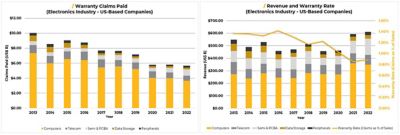ANSYS 部落格
January 26, 2024
保固成本指南:如何降低未來保固索賠
無論您是負責退換貨與維修的產品線經理,還是每季都在關注保固成本如何侵蝕利潤的財務長 (CFO),您都希望能瞭解如何降低保固成本。雖然期望保固成本為零並不現實,但有方法可以最小化保固索賠的頻率與影響。
檢視電子產業現況
2022 年,美國電子產業的保固索賠金額超過 55 億美元。這個數字看似龐大,但相比 10 年前已下降超過 40%,同期間產業營收則成長了超過 11%。保固率 (即索賠金額占銷售額的比例) 已下降至接近歷史低點。下圖說明過去 10 年間產業所達成的成果。

提高產品可靠性與更完善的保固管理實務,為美國電子產業帶來了豐碩成果。
尋找合作夥伴,而非僅僅是產品
在過去18年中,Ansys可靠度工程服務 (RES) 已協助數千家電子公司找出並解決產品可靠性問題。
若您希望提升產品可靠性,不妨參考那些成功企業所採取的步驟:
- 建立可靠度觀念:可靠性物理分析 (RPA) 旨在瞭解導致產品故障背後的物理機制。成功導入此方法需 (透過模擬、測試、研究等方式),進行深入探究,並瞭解使用環境如何影響產品、次系統與元件的可靠性。使用環境可能包括老化測試、電路內測試、儲存、運輸,以及實際操作使用等情境。在整個產品開發週期中運用 RPA 原則的企業,能在設計階段掌握產品的故障風險與可能的故障機制,並進一步消除根本原因或降低故障對終端使用者的影響。
- 及早進行模擬:工程模擬可協助企業縮短設計與實際表現之間的差距。將模擬整合至設計流程中,結合明確定義的材料特性與對使用環境的理解──這些同樣是 RPA 成功的關鍵──可讓工程師在設計定案前以虛擬方式驗證其構想。及早導入模擬有助於企業大幅減少設計反覆、原型製作與測試次數,同時避免在量產、驗證或實際使用階段發生高成本的失敗。將模擬與設計緊密結合,可讓企業在產品進入量產與交付給最終使用者之前,及早發現並排除潛在弱點。
- 採用卓越設計 (DfX) 方法進行設計:DfX 是一種系統化且前瞻性的設計方法,運用產品開發流程中其他領域專家的知識與經驗 (如測試、製造、物流、營運與維護),確保最終產品在達成可靠性、品質、耐用性與顧客期望目標的同時,亦能以合理的生命週期成本實現。DfX 實務者經常強調其在節省成本與加速上市方面的成效,但其核心在於打造能在整個生命週期中穩定運作的產品,從而降低現場故障率與保固退貨率。
- 納入以可靠性為核心的設計審查:每個產品設計團隊都會定期進行設計審查,但他們是否聚焦在正確的重點上呢?設計審查通常著重於性能與功能需求、法規、產業標準及設計規則的符合性。這些都是非常重要的考量因素。以可靠度為核心的設計審查則特別著重於確保產品能達到或超越其可靠度目標。也就是說,產品是否能在預期的使用環境中於預定期間內正常執行其設計功能?在達到關鍵設計節點前回答這些問題並採取行動解決潛在問題,可確保可靠度自設計階段即被納入產品中,而非等到量產、驗證、老化測試或處理保固退貨時才試圖找出並修正可靠度問題。欲了解更多資訊,請參閱手冊《電子組件設計審查權威指南》。
- 進行徹底的根本原因分析:即便企業盡最大努力,產品仍可能發生意料之外的故障。除了前述實用的設計實務外,在測試、量產與交付前進行良好的篩選程序,也有助於預防產品保固退貨。然而,在產品的生命週期中,您終究需要釐清其故障原因。找到產品的裂痕、短路或其他造成產品失效的損壞,只是故障分析的起點,而非終點。最優秀的故障分析人員會運用可靠度觀念,判斷環境如何造成所觀察到的損壞 (即故障機制),以及該損壞如何導致產品以特定方式失效 (即故障模式)。深入瞭解故障背後的物理機制,有助於企業找出並消除真正的根本原因,進而更有依據地決定是否進行重新設計、維修、保養或其他補救措施,以降低後續故障與保固退貨的發生率。欲瞭解更多資訊,請閱讀「Ansys 可靠度工程服務團隊協助電子製造商找出故障根本原因」。
無論您是原始設備製造商 (OEM) 或電子產品供應商,都能從業界其他公司歷經挑戰所累積的寶貴經驗中獲益。請聯絡 Ansys 可靠度工程服務 (RES) 團隊運用數十年的電子產品可靠度專業,為您提供協助,提升產品的可靠度。